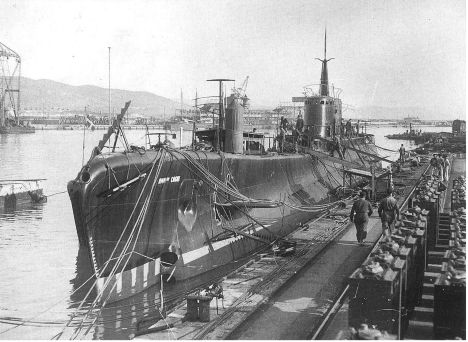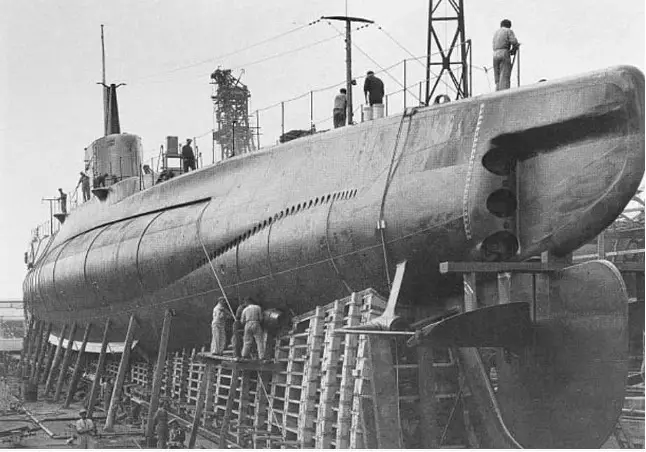
The pinnacle in the evolution of Italian ocean-going submarines, these were the largest underwater units of the type ever designed by Italy
Design and specification
In the interwar period, the construction of Italian submarines concentrated on two main kinds of boats, Ocean going submarines meant for long-range hunting patrols, and coastal submarines, meant for Mediterranean use. In late 1939, the Regia Marina laid down its four ocean-going submarines of the latest kind, the “Ammiragli” class. These were impressive boats in size, displacing 1,700 tons while surfaced and 2,300 submerged, with a length of 87,90 meters.
A characteristic of these units was the armament, they had 14 torpedo tubes, eight forward and six aft, and carried the record number of 38 torpedoes. These were the 450 mm torpedoes, deemed sufficient against little or no protected targets such as merchant ships. In addition, these weapons could be moved from bow to stern and vice versa. They also had two 100/47mm guns and four 13,2mm machine guns for anti-aircraft fire. The estimated range was around 19,500 miles at seven knots of speed or 10,200 miles at 12 knots. Like all submarines of this era, they had a diesel engine for surface navigation (4,370 hp) and an electric engine (1,800 hp) for submerged navigation.
Four submarines of the class were built: Ammiraglio Saint Bon, Ammiraglio Cagni, Ammiraglio Millo, and Ammiraglio Caracciolo. They were launched in late 1940 and entered service in the summer 1941. Although they were designed for ocean convoy hunting, only one unit ended up fighting in this role.
Ammiraglio Saint Bon
War needs of late 1941 meant that the first mission of Saint Bon was the transport of 153 tons of petrol cans to Bardia. The large internal spaces of the Ammiragli class boats meant that they were suitable for the role. The sub departed from Taranto on the 10th of October 1941 and during the voyage suffered from two air attacks but came out unharmed, delivering the materials to the destination.
Again, in November and December, Saint Bon performed two more successful transport missions towards Bardia and Derna.
On the 4th of January 1942, the submarine left Taranto with a cargo of 155.4 tons, mostly petrol cans. On the next day, Saint Bon got hit by a torpedo from the British submarine Upholder. The explosion ignited the highly flammable cargo causing the quick sinking of the boat, with only three crew members surviving.
Ammiraglio Cagni
On the 15th of October 1941, Ammiraglio Cagni set sail from Taranto with a load of 140 t of fuel cans and anti-tank ammunition, bound for Bardia. She returned to Taranto on the 22nd and repeated the mission in November.
After more transport operations and offensive patrols in the Mediterranean, in October 1942, Ammiraglio Cagni was destined to operate in the Atlantic. After crossing unharmed the strait of Gibraltar, the submarine sunk the British-armed merchant Dacomba.
The Cagni cruised along the African coast reaching the waters off the Cape of Good Hope where she sank the Greek steamer Argo of 1,995 GRT.

Figure 1 The Ammiraglio Cagni
It sailed back and returned to the Betasom base in Bordeaux after 136 days of the mission, establishing the absolute record of permanence at sea among Italian submarines in WW2 (6th October 1942 – 20th February 1943)
The last mission of the Cagni began on the 29th of June and lasted for 84 days, until the 20th of September 1943. The Cagni had to attack merchant traffic in the South Atlantic and Indian Oceans, reach Singapore to load a cargo of precious rubber and tin and then head back to Europe.
During the voyage, the submarine sunk a steamer off the Canary Islands On the 25th of July she damaged the auxiliary cruiser Asturias, of 22,048 GRT, a passenger steamer converted into an auxiliary cruiser with 8 x 152 mm guns, 3 x 76 mm guns.
On the 30th of July, the Cagni crossed the equator and entered the Indian Ocean at the end of August. On 8 September the unit was only 1800 miles from Singapore when she received the news of the armistice and the order to proceed to the Allied port of Durban, where she arrived on the 20th of September.
In November, the Cagni departed to return to Taranto, which reached on the 2nd of January 1944. For the rest of the war, the Cagni joined the Allied navies in intense antisubmarine training activities. The unit was scrapped in 1948 following the terms of the peace treaty.
Ammiraglio Millo
Like the other units of the class, the Ammiraglio Millo carried out a series of offensive patrols and transport missions in the Mediterranean, in which she transported a total of 623.2 tons of supplies, mostly fuel and ammunition.
On the 14th of March 1942, while returning to Taranto, the Millo was attacked by the British submarine HMS Ultimatum, which launched four torpedoes. Hit amidships and aft by two torpedoes, she sank immediately. 57 men and over 71 crew members were killed.
Ammiraglio Caracciolo
Of the four Ammiragli class submarines, the Caracciolo had the shortest career. The boat left Taranto on the 8th of December with a cargo of 140.1 tons of supplies bound for Bardia. The material safely landed in Bardia on the 10th and the Caracciolo left the same day with Italian and German personnel, bound for Souda bay (Creete).

Figure 2 The Ammiraglio Caracciolo
On the next day, the submarine sighted an escorted convoy, en route to Alexandria, and launched two torpedoes with no result. Another attack was unsuccessful and then two British destroyers came to attack. The Caracciolo tried to evade but became subjected to several depth charge drops that caused serious damage on board, forcing the commander to order the emersion. Once surfaced, the submarine was hit by enemy artillery fire, which caused her rapid sinking. 16 men perished while 53 survivors were recovered from the British destroyers.
Sources
Bagnasco, E., & Brescia, M. (2014). I sommergibili italiani 1940-1943, Parte II – Oceani.
Giorgerini, G. (1994). Uomini sul fondo.
